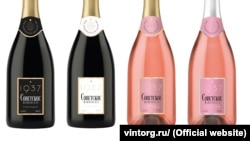For decades, no table set for a Russian -- or Soviet -- New Year’s celebration would have been complete without a bottle of Soviet Champagne. Or birthdays, or weddings, or any other boozy celebrations.
The nostalgia factor is high, says the company that holds the rights to distribute and market the sparkling wine within Russia. And that’s why the company has opted to make the year when the fizzy tipple first started being fermented -- 1937 -- central to a new marketing campaign.
Except that’s the year when Stalin’s Great Terror was ramping up, a murderous purge resulting in the deaths of hundreds of thousands of people -- an inauspicious and tone-deaf marketing gimmick for some Russians.
“Honestly speaking, I can’t believe this,” Sergei Parkhomenko, a prominent liberal commentator, wrote on his Facebook page. “This must be some kind of joke.”
Known as Sovietskoye Shampanskoye, the brand was owned by Soyuzplodoimport, a company first established in 1966 to oversee the export of nearly all Soviet agriculture products. It was privatized during the Soviet collapse, but, facing serious financial problems, ended up selling trademarks for many of its best-known Soviet-era brands, including Stolichnaya vodka.
Despite the Soviet collapse, the wine’s name remained unchanged -- a reflection in part of Russians’ ambivalent feelings about the consequences of the end of the U.S.S.R.
In 2001, the government revived Soyuzplodoimport, bestowing it with its famous vodka -- on the domestic market -- but also other well-established brands, including Soviet Champagne (which technically speaking isn’t champagne since it does not hail from the famous French region, a detail that didn’t really concern Soviet authorities).
This summer, a Moscow-region company called Vintorg acquired the rights to distribute and market the wine within Russia -- and announced it would relabel it with the date 1937 prominent on its bottles.
“Marketing research…showed that Russian consumers are proud of the history of the Sovietskoye brand, appreciate nostalgic memories and its associations, but need a fresher reading of this history," the company said in a press release announcing the deal.
The company did not respond to e-mail requests from RFE/RL’s Russian Service seeking further comment.
Soyuzplodoimport, meanwhile, confirmed to RFE/RL that it considered 1937 the “official birthday” of Soviet Champagne, and defended the prominence given to the year on the new marketing.
“Any significant brand would consider its establishment to be an essential part of its image, and use it frequently as part of the logo,” Soyuzplodoimport said.
It’s unclear how widely Parkhomenko’s outrage is shared by Russian consumers, who are increasingly shunning traditional Russian vodka and turning to beer and wine, particularly those brands imported from abroad.
Mikhail Smirnov, editor of a Russian news site focusing on the Russian beverage industry, said sparkling wines began to be produced in the Soviet Union only in the 1920 and '30s.
In the mid-'30s, Stalin ordered Soviet agriculture planners to begin cultivating champagne grapes for mass production of the sparkling wine.
“Stalin decreed that the proletariat should have champagne on the table,” Smirnov said, and he ordered Anastas Mikoyan, a member of Stalin’s Politburo and a leading planner for Soviet agriculture production, to do it. (Mikoyan was also known for increasing production of ice cream, as well as meat production.)
In 1937, Stalin’s Great Terror was nearing its height, as hundreds of thousands were arrested by the secret police, purged from the Communist Party, and accused of various political crimes. More than 1.2 million people ended up being arrested, according to Russian and Western historians; at least 680,000 were estimated to have been executed or died in labor camps as part of the gulag.
In Russia, Smirnov said sparkling wines -- domestic or imported -- are most in demand for the New Year’s holidays, as well as International Women’s Day on March 8.
Denis Puzyrev, who publishes commentary on the Russian beverage industry on the Telegram channel Drunken Master, said big retailers are wary of marketing Soviet Champagne with 1937 on the label.
He also doubted that the rebranding would increase sales since Russian connoisseurs have plenty of options for sparkling wines.
Aleksei Makarov, a historian with Memorial, a Russian rights group that has documented the victims of Stalin’s purges and the secret police, said that, strictly speaking, neither Vintorg nor Soyuzplodoimport have violated anything.
Russia has no legislation that might regulate, say, how Stalin-era victims are memorialized, he said. Moreover, there are plenty of food brands that have associations with the Soviet era, or even with the repressive 1930s.
“The owners of these brands do not have bother with any such introspection,” he said.









